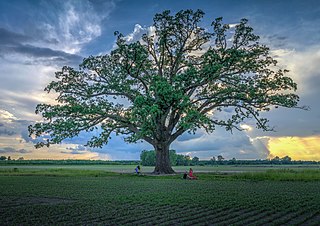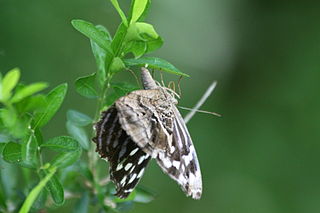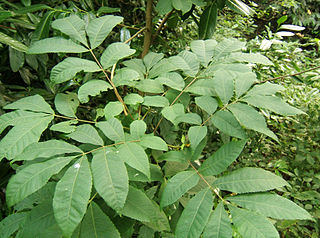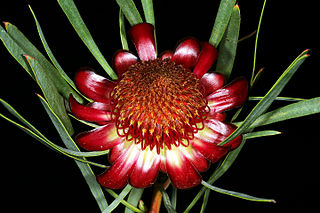
Quercus muehlenbergii, the chinkapin or chinquapin oak, is a deciduous species of tree in the white oak group. The species was often called Quercus acuminata in older literature. Quercus muehlenbergii is native to eastern and central North America. It ranges from Vermont to Minnesota, south to the Florida panhandle, and west to New Mexico in the United States. In Canada it is only found in southern Ontario, and in Mexico it ranges from Coahuila south to Hidalgo.

Ptelea trifoliata, commonly known as common hoptree, wafer ash, stinking ash, and skunk bush, is a species of flowering plant in the citrus family (Rutaceae). It is native to North America, where it is found in Canada, Mexico, and the United States. It is a deciduous shrub or tree, with alternate, trifoliate leaves.

Quercus macrocarpa, the bur oak, commonly spelled burr oak, is a species of oak tree native to eastern North America. It is in the white oak section, Quercus sect. Quercus, and is also called mossycup oak, mossycup white oak, blue oak, or scrub oak. The acorns are the largest of any North American oak, and are important food for wildlife.

Quercus michauxii, the swamp chestnut oak, is a species of oak in the white oak section Quercus section Quercus in the beech family. It is native to bottomlands and wetlands in the southeastern and midwestern United States, in coastal states from New Jersey to Texas, inland primarily in the Mississippi–Ohio Valley as far as Oklahoma, Missouri, Illinois, and Indiana.

Magnolia acuminata, commonly called the cucumber tree, cucumber magnolia or blue magnolia, is one of the largest magnolias, and one of the cold-hardiest. It is a large forest tree of the Eastern United States and Southern Ontario in Canada. It is a tree that tends to occur singly as scattered specimens, rather than in groves.

Magnolia grandiflora, commonly known as the southern magnolia or bull bay, is a tree of the family Magnoliaceae native to the southeastern United States, from Virginia to central Florida, and west to East Texas. Reaching 27.5 m (90 ft) in height, it is a large, striking evergreen tree, with large dark green leaves up to 20 cm long and 12 cm wide, and large, white, fragrant flowers up to 30 cm (12 in) in diameter.

Arethusa bulbosa, commonly called dragon's mouth orchid, is the only species in the orchid genus Arethusa. The genus is named after a naiad of Greek mythology. This monotypic genus is abbreviated Aret in trade journals.

Adelia is a genus of flowering plants in the spurge family, Euphorbiaceae, subfamily Acalyphoideae. It is native to Latin America and the Caribbean, with one species extending northward into the southernmost part of Texas.

Carya cordiformis, the bitternut hickory, also called bitternut or swamp hickory, is a large pecan hickory with commercial stands located mostly north of the other pecan hickories. Bitternut hickory is cut and sold in mixture with the true hickories. It is the shortest-lived of the hickories, living to about 200 years.

Acer leucoderme is a deciduous tree native to the southeastern United States from North Carolina south to northwest Florida and west to eastern Texas. It lives in the understory in moist, rocky soils on river banks, ravines, woods, and cliffs. Although generally a uncommon tree, it is most often found in the inner coastal plain and Piedmont regions of Georgia.

Quercus lyrata, the overcup oak, is an oak in the white oak group. The common name, overcup oak, refers to its acorns that are mostly enclosed within the acorn cup. It is native to lowland wetlands in the eastern and south-central United States, in all the coastal states from New Jersey to Texas, inland as far as Oklahoma, Missouri, and Illinois. There are historical reports of it growing in Iowa, but the species appears to have been extirpated there. It is a slow-growing tree that often takes 25 to 30 years to mature. It has an estimated lifespan of 400 years.

Cephalanthus occidentalis is a species of flowering plant in the family Rubiaceae, that is native to eastern and southern North America. Common names include buttonbush, common buttonbush, button-willow and honey-bells.

Forestiera is a genus of flowering plants in the olive family, Oleaceae. Members of the genus are often called swampprivets. Most are shrubs.

Forestiera pubescens, commonly known as stretchberry, desert olive, tanglewood, devil's elbow, spring goldenglow, spring herald, New Mexico privet, or Texas forsythia is a deciduous shrub or small tree native to the southwestern United States and northern Mexico.

Malus angustifolia, or southern crabapple, is a species of crabapple native to the eastern and south-central United States from Florida west to eastern Texas and north to New Jersey, Pennsylvania, Illinois and Missouri.

Melaleuca ericifolia, commonly known as swamp paperbark, is a plant in the myrtle family, Myrtaceae and the genus Melaleuca, native to south-eastern Australia. It is a rather variable species and some specimens resemble Melaleuca armillaris but its papery bark and smaller, more prolific flower heads distinguish it from that species. It often grows in swampy areas and the draining and clearing of these has reduced the numbers of the species, especially around Port Philip Bay near Melbourne. It is also similar to Melaleuca pustulata, a Tasmanian endemic, but that species only grows in dry heath.

Alisma subcordatum, the American water plantain, is a perennial aquatic plant in the water-plantain family (Alismataceae). This plant grows to about 3 feet in height with lance to oval shaped leaves rising from bulbous corms with fibrous roots. Any leaves that form underwater are weak and quick to rot; they rarely remain on adult plants. A branched inflorescence with white to pink 3-petaled flowers blooms from June to September. The seeds are eaten by waterfowl and upland birds. Native Americans dried and ate the submerged rootlike structures. The species name subcordatum means "almost heart-shaped".

Nyssa biflora, commonly referred to as the swamp tupelo, or swamp black-gum is a species of tupelo that lives in wetland habitats. Swamp tupelo grows chiefly in the coastal plains from Delaware, eastern Maryland, and southeastern Virginia, south to southern Florida and west to eastern Texas. Its range extends north up the Mississippi Valley to southern Arkansas and west and south Tennessee.

Styrax americanus, the American snowbell or mock-orange, is a plant species native to the southeastern United States and the Ohio Valley. It has been reported from Texas and Florida to Virginia and Missouri. It generally grows in swamps and on floodplains and in other wet locations.

Protea acuminata, also known in English as the black-rim sugarbush, or in the Afrikaans language as sederbergsuikerbos, is a flowering shrub belonging to the genus Protea. The plant is endemic to South Africa. There are isolated populations at Nieuwoudtville, and in the Cederberg, Stettynskloof and Riviersonderend Mountains. It can grow as an upright tree. It can become up to two metres in height. It blooms from June to September, with the peak of July to August. Periodic wildfires may destroy the adult plants, but the seeds can survive such an event. The seeds are dispersed by means of the wind. The plant is monoecious with both sexes in each flower. It is unknown what causes the pollination to occur. The plant grows in sandy plains and coastal lowlands from sea-level to altitudes of 400 metres. It is a widespread species which is not in danger, and the conservation status has been assessed as 'least concern'.






















